cities
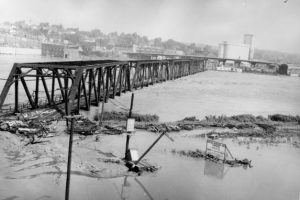 Rain…it waters the earth, and as we all know, without it, we could not survive. Nevertheless, as vital as water is to life on this planet, too much of it can be deadly. People can drink too much water, we can over-water our plants, and too much rain can bring flooding. Such was the case on July 13, 1951. Above-average rainfall began in June and continued through July 13th, dumping well over 25 inches on some areas in eastern Kansas. From July 9th to 13th, nearly 6 inches of rain fell. The Kansas, Neosho, and Verdigris rivers began taking on more water than their normal carrying capacity a couple of days into the storm, but as the rain persisted, flooding began all over the region.
Rain…it waters the earth, and as we all know, without it, we could not survive. Nevertheless, as vital as water is to life on this planet, too much of it can be deadly. People can drink too much water, we can over-water our plants, and too much rain can bring flooding. Such was the case on July 13, 1951. Above-average rainfall began in June and continued through July 13th, dumping well over 25 inches on some areas in eastern Kansas. From July 9th to 13th, nearly 6 inches of rain fell. The Kansas, Neosho, and Verdigris rivers began taking on more water than their normal carrying capacity a couple of days into the storm, but as the rain persisted, flooding began all over the region.
The major towns of Manhattan, Topeka and Lawrence took the biggest hit. As is 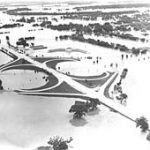 the case in any area where absorption is hampered by cement and asphalt, the rain could not soak in, and the ground was are already saturated anyway. The rain had nowhere to go, and the area was in trouble. Prior to the July 13 river crest, previous highs were dwarfed by four to nine feet. Two million acres of farmland were lost to the flood, which would trigger a crisis of its own, by a shortage of food. The flooding also caused fires and explosions in refinery oil tanks on the banks of the Kansas River. Passenger trains traveling through the area were stuck for nearly four days. In all, $760 million in damages were caused by the flood, and 500,000 people were left homeless, while 24 people died in the disaster. It was the greatest destruction from flooding in the Midwestern United States up to that time.
the case in any area where absorption is hampered by cement and asphalt, the rain could not soak in, and the ground was are already saturated anyway. The rain had nowhere to go, and the area was in trouble. Prior to the July 13 river crest, previous highs were dwarfed by four to nine feet. Two million acres of farmland were lost to the flood, which would trigger a crisis of its own, by a shortage of food. The flooding also caused fires and explosions in refinery oil tanks on the banks of the Kansas River. Passenger trains traveling through the area were stuck for nearly four days. In all, $760 million in damages were caused by the flood, and 500,000 people were left homeless, while 24 people died in the disaster. It was the greatest destruction from flooding in the Midwestern United States up to that time.
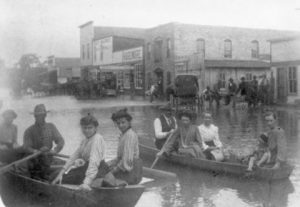
A often happen, tragedy brings change. Following the great 1951 flood, a series of reservoirs and levees were constructed all over the area. In 1993, these were credited with minimizing the damage from another record flood. Water is an element that is necessary for life, but lest we forget, water in an overabundance can kill and destroy. People need to pay attention to evacuation warnings, and get out of an area where a flood is eminent. You may lose some things, but if you leave the area, you will most likely to walk away unscathed, and as we know, things can be predicted, and those who head out of unsafe areas will most likely live to tell the tale.
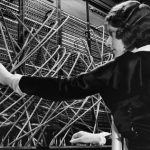 Years ago, when the telephone first came out, the only way to call someone, if they had a phone, that is, was to go through the operator. Basically, you picked up your phone, and often, cranked a ringer to get the attention of the operator, and then told them who you wanted to talk to. The operator would then connect you with the person you were calling by way of a switchboard. Of course, that meant that the operator could also stay on the line and listen to the whole conversation, if she chose to do so. The switchboard operator was needed to make any call except if two people had a party line.
Years ago, when the telephone first came out, the only way to call someone, if they had a phone, that is, was to go through the operator. Basically, you picked up your phone, and often, cranked a ringer to get the attention of the operator, and then told them who you wanted to talk to. The operator would then connect you with the person you were calling by way of a switchboard. Of course, that meant that the operator could also stay on the line and listen to the whole conversation, if she chose to do so. The switchboard operator was needed to make any call except if two people had a party line.
Many people have no idea what a party line is, but my friend Gale Dugger Oskolkoff had one when her family lived in the Casper area, and her, her sisters, and I used to have a great time listening in on the calls that were made to a girl who had the unfortunate position of being a teenaged girl with a boyfriend and a party line. She use to get so mad at us. I don’t even know her name, but if she could have, I think she would have reached through the phone and choked us. Of course, I feel sorry for her now, because there was pretty much no privacy in her love life, but it was fun…for us anyway.
Before long, party lines became a thing of the past, and while direct distance dialing came into being before party lines went out, direct distance dialing was a brand new technology on November 10, 1951, when it was first offered on trial basis at Englewood, New Jersey, to 11 selected major cities across the United States. This service grew rapidly across major cities during the 1950s. The first direct-dialed long-distance telephone calls were possible in the New Jersey communities of Englewood and Teaneck. Customers of the ENglewood 3, ENglewood 4 and TEaneck 7 exchanges, who could already dial New York City and area, were able to dial 11 cities across the United States, simply by dialing the three-digit area code and the seven-digit number, which at the time consisted of the first two letters of the central office name and five digits. On November 10, 1951, Englewood Mayor M. Leslie Denning made the first customer-dialed long distance call, to Mayor Frank Osborne of Alameda, California.
The eleven destinations at that time were:
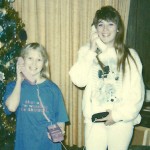
617: Boston, Massachusetts
312: Chicago, Illinois
216: Cleveland, Ohio
313: Detroit, Michigan
414: Milwaukee, Wisconsin
415: Oakland, California
215: Philadelphia, Pennsylvania
412: Pittsburgh, Pennsylvania
401: Providence, Rhode Island
916: Sacramento, California
318: San Francisco – San Francisco required the special code 318 for temporary routing requirements
Many other cities could not be included, as they did not yet have the necessary toll switching equipment to handle incoming calls automatically on their circuits. As with any technology, these changes take time to implement. Other cities still had either a mixture of local number lengths or were all still six-digit numbers. Montreal, Quebec and Toronto, Ontario in Canada, for example, had a mix of six and seven-digit numbers from 1951 to 1957, and did not have direct distance dialing until 1958. Whitehorse, Yukon, had seven-digit numbers from 1965, but the necessary switching equipment was not in place locally until 1972.

These days, all this seems completely archaic, considering the fact that even the phone lines that were installed on poles and underground are almost not necessary in today’s world. With the implementation of wireless…everything, we no longer need to have a phone line to have a phone, and in fact a home phone is not necessary for most people, because a cellular phone can be taken with us where ever we go, so we never need to miss a call, unless our work does not allow us to have the phone with us. Phones have come a long way since the days of switchboards, operators, and phone lines, and I think most of us would agree that it’s better now, although there are those who like to be disconnected.

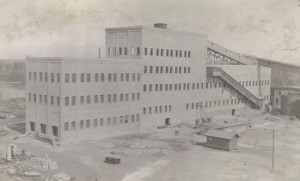 As people moved West, in search of the wide open spaces, they were leaving the hustle and bustle of the big cities behind…in search of not only a better life, but maybe for the quiet life too. The East was crowded, and loud, and those people who were ready for something different, decided to make the trip out West, where there were still wide open spaces. The funny thing was that they didn’t even have to go all the way to the West coast to be west of where they were. Many families made it as far as what we would call the Midwest, but that was good enough. There was plenty of land to spread out on and it was available. And so the country began to grow. It really was inevitable anyway, whether it happened then or later. As people grow up and have families, the population grows. It just doesn’t take long to overpopulate a small area. There are few options left, the best one being for some people to move away.
As people moved West, in search of the wide open spaces, they were leaving the hustle and bustle of the big cities behind…in search of not only a better life, but maybe for the quiet life too. The East was crowded, and loud, and those people who were ready for something different, decided to make the trip out West, where there were still wide open spaces. The funny thing was that they didn’t even have to go all the way to the West coast to be west of where they were. Many families made it as far as what we would call the Midwest, but that was good enough. There was plenty of land to spread out on and it was available. And so the country began to grow. It really was inevitable anyway, whether it happened then or later. As people grow up and have families, the population grows. It just doesn’t take long to overpopulate a small area. There are few options left, the best one being for some people to move away.
I understand how they feel. While I have had my time living in the country, and I would not go back again, I am also drawn to the wide open spaces…or at least the long trails. It is such a great feeling to be able get away from it all, and just listen to the quiet for a while. Of course, the quiet is never totally quiet, but rather is has many sounds in it, like the birds chirping, the breeze blowing, bugs making their sounds, or a creek bubbling along. Nevertheless, quiet or not, it’s different, and that makes it the kind of peaceful sounds you need. And for 
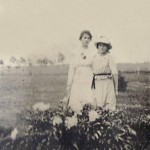 me, a few days hiking on a long trail through the mountains and forests, is just what I need to renew my sense of balance and peace. Does that mean that I would love to have been one of the pioneers who went out West to find a better life…no, I don’t think so. Life was hard for the pioneers. In reality, they paid dearly for the quiet life. There were no stores, or at least, not many. Water was scarce. They have to grow food. They worked hard…from morning to night. Yes, it was the quiet life, but it wasn’t easy…and that’s for sure.
me, a few days hiking on a long trail through the mountains and forests, is just what I need to renew my sense of balance and peace. Does that mean that I would love to have been one of the pioneers who went out West to find a better life…no, I don’t think so. Life was hard for the pioneers. In reality, they paid dearly for the quiet life. There were no stores, or at least, not many. Water was scarce. They have to grow food. They worked hard…from morning to night. Yes, it was the quiet life, but it wasn’t easy…and that’s for sure.
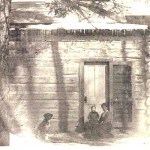 In years gone by, when it wasn’t as easy to get to your job site as it is today, many people lived as near their work as possible, especially when their work was out in the woods. Jobs in the cities and towns don’t require long drives, but when you travel on a horse, and work from sunrise to sunset; it’s nice to be close to home. Working in the logging industry, like my grandparents did, living in the woods was just part of the job.
In years gone by, when it wasn’t as easy to get to your job site as it is today, many people lived as near their work as possible, especially when their work was out in the woods. Jobs in the cities and towns don’t require long drives, but when you travel on a horse, and work from sunrise to sunset; it’s nice to be close to home. Working in the logging industry, like my grandparents did, living in the woods was just part of the job.
I’m told that their little cabin in the woods was near International Falls, Minnesota, where their daughter, my Aunt Laura was born. I would imagine that the winters were very cold there, and the best thing for anyone who could was to stay indoors, but them I seriously doubt that my grandmother was a woman who was afraid of a little but of cold and snow. Still, the cold and snow would really make it hard to work out in the woods…nevertheless, that was the job that had to be done. Maybe that was another good reason to live near your work. You could get home to the nice warm house sooner, and maybe 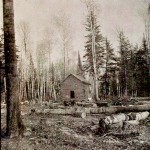 even be able to go home for lunch.
even be able to go home for lunch.
When I look at these pictures, it reminds me of the “Little House on the Prairie” books. Everywhere you look seems to be a new adventure. I can imagine how the Ingalls girls felt living there…the adventures they must have had…the adventures my Aunt Laura must have had there, playing with the children of the other logging families that lived in the woods too. I’m sure there was an abundance of forest animals to see and be in awe of. I love photographing the animals…when I happen to be in the right place at the right time. The pictures can be amazing. I can imagine all the beauty all around the little cabin in the woods.
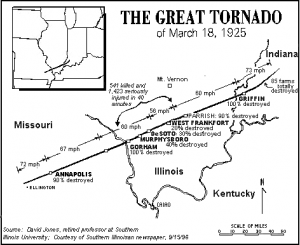 After writing about the worst winter ever, I began to look into other severe weather that made a big impact on a lot of lives, and might possibly have had an impact on my own family. I came across a tornado on this day, March 18, 1925 that was and still is the deadliest tornado in history. This tornado touched down at 1:00pm near Ellington, Missouri, and over the next 3 1/2 hours it tore across 3 states and 219 miles, finally ending up in Outsville, Indiana at 4:30 pm, where it hit one house and then dissipated. A tornado traveling this distance is virtually unheard of, but as we all know from this even…not impossible. This tornado was an F5 on the Fujita Scale. In all, the Tri-State Tornado, as it has since been called, hit more that 19 communities in Missouri, Illinois, and Indiana, while making an almost straight path across the 3 states.
After writing about the worst winter ever, I began to look into other severe weather that made a big impact on a lot of lives, and might possibly have had an impact on my own family. I came across a tornado on this day, March 18, 1925 that was and still is the deadliest tornado in history. This tornado touched down at 1:00pm near Ellington, Missouri, and over the next 3 1/2 hours it tore across 3 states and 219 miles, finally ending up in Outsville, Indiana at 4:30 pm, where it hit one house and then dissipated. A tornado traveling this distance is virtually unheard of, but as we all know from this even…not impossible. This tornado was an F5 on the Fujita Scale. In all, the Tri-State Tornado, as it has since been called, hit more that 19 communities in Missouri, Illinois, and Indiana, while making an almost straight path across the 3 states.
I don’t know if any of the 695 people who perished in the most deadly tornado in history, were related to me or not, but in studying my family history, I can say the I had family in those 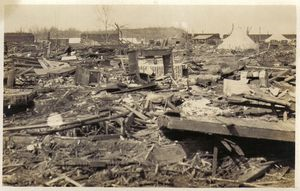 areas. In all likelihood, one or more of them were related, and when I think of the horror of their last moments, whether they were related or not…well, it is beyond horrible. In Missouri, 13 people lost their lives. In Illinois, 541 people lost their lives, with 234 in Murphysboro alone, which is a record for a single community, and there were 33 deaths at the De Soto school, which was a record for such a storm, and with only bombs and explosions taking higher school tolls. In Indiana 76 people lost their lives. The numbers are not exact. Some accounts say 630 and others say 689, while still others say 695. I find that in itself sad. It is always sad when lives lost go unaccounted for. In all, there were 2,027 injuries and 15,000 homes destroyed. I have been looking over the victims lists, and some of the last names are familiar to me, but I can’t say that these people were or were not related to me. Also, the lists that I found, were not complete lists. It may take a bit of
areas. In all likelihood, one or more of them were related, and when I think of the horror of their last moments, whether they were related or not…well, it is beyond horrible. In Missouri, 13 people lost their lives. In Illinois, 541 people lost their lives, with 234 in Murphysboro alone, which is a record for a single community, and there were 33 deaths at the De Soto school, which was a record for such a storm, and with only bombs and explosions taking higher school tolls. In Indiana 76 people lost their lives. The numbers are not exact. Some accounts say 630 and others say 689, while still others say 695. I find that in itself sad. It is always sad when lives lost go unaccounted for. In all, there were 2,027 injuries and 15,000 homes destroyed. I have been looking over the victims lists, and some of the last names are familiar to me, but I can’t say that these people were or were not related to me. Also, the lists that I found, were not complete lists. It may take a bit of 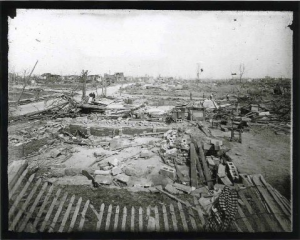 research to know for sure.
research to know for sure.
It doesn’t really matter whether I am related to any of the victims or not, the reality of this kind of devastation is beyond horrible. Of the 19+ communities, 5 were virtually destroyed along with more than 85 farms. I did find out that at the time of the Tri-State Tornado, my great great grandmother was living just 36 miles north of its path. One of the names might have been a cousin or nephew. Even knowing there is a possibility makes me sad. It is very hard to think about the family members of the victims who are left behind.

